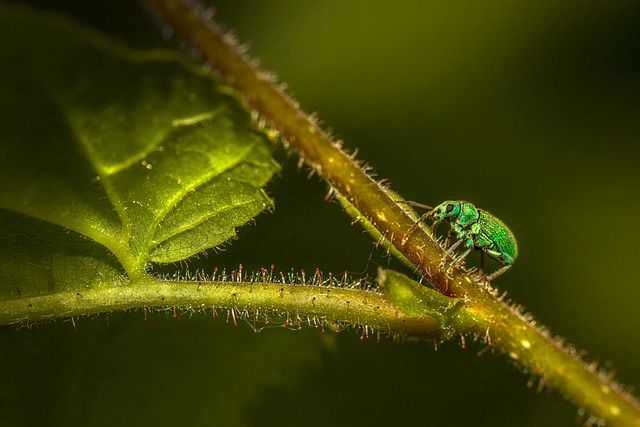Grain weevils (Rhyzopertha dominica) are persistent pests that threaten stored grains and agricultural products, especially in warm, humid areas with poor ventilation. Early detection through regular inspections is crucial for effective residential weevil treatment. Professional inspectors meticulously search for weevils, larvae, and frass in hard-to-reach areas to uncover breeding sites. These experts assess food sources and environmental conditions, implement tailored treatments, and provide durable solutions. Early intervention prevents structural damage and ensures the integrity of affected structures. Targeted insecticide applications, proper storage practices, regular cleaning, and sealing entry points are key components of successful residential weevil treatment strategies.
Thorough inspections are crucial in identifying grain weevil activity and breeding sites, especially in residential areas. These tiny pests can cause significant damage to stored grains and food products. By understanding their behavior and breeding patterns, property owners can effectively navigate residential weevil treatment. This article guides you through the process, from recognizing common breeding sites to implementing post-inspection strategies for eradication and prevention.
Understanding Grain Weevils: Behavior and Breeding Patterns
Grain weevils, scientifically known as Rhyzopertha dominica, are small but formidable pests that can cause significant damage to stored grains and other agricultural products. Understanding their behavior and breeding patterns is crucial for effective residential weevil treatment. These insects have a strong preference for warm, moist environments, making them particularly prevalent in areas with poor ventilation and high humidity, such as attics, cellars, and grain silos.
Grain weevils breed rapidly, with females laying hundreds of eggs over their short lifespan. The larvae, which can survive for several months, feed on the starch in grains, causing significant weight loss and reducing the value of stored products. Regular inspections are vital to identify active breeding sites, which often go unnoticed due to the discreet nature of these pests. Thorough checking involves examining the presence of adult weevils, larvae, or their distinctive frass (excrement) in stored grain, ensuring prompt intervention for effective residential weevil treatment.
The Role of Thorough Inspections in Residential Weevil Treatment
Thorough inspections play a pivotal role in effective residential weevil treatment strategies. By meticulously examining residences, particularly hard-to-reach areas and hidden corners, professionals can uncover signs of grain weevil activity and breeding sites that may be invisible to the untrained eye. These inspections involve a systematic search for weevils themselves, as well as their discarded exoskeletons, larvae, or eggshells, which indicate recent or ongoing infestations.
During these inspections, trained technicians also assess potential food sources and environmental conditions that favor weevil breeding, such as the presence of grains, seeds, or other stored products. By identifying and addressing these factors, they can implement tailored treatments to disrupt weevil life cycles, prevent future infestations, and ensure a durable residential weevil treatment solution.
Identifying Breeding Sites: Common Areas and Potential Risks
Grain weevils are adept at finding and utilizing hidden spaces within homes, making their breeding sites hard to spot. Common areas where these pests tend to establish include kitchens, pantries, and storage rooms—anyplace with access to grains, seeds, or dried goods. They’re attracted to starchy materials like pasta, rice, cereal, and even paper products, so areas with high organic content are particularly vulnerable.
Potential risks increase if these weevils go unnoticed. Over time, their breeding sites can proliferate, leading to significant infestations that require professional residential weevil treatment. Moreover, grain weevils can cause structural damage by boring into wood and cardboard, posing additional risks to the integrity of affected structures. Regular, thorough inspections are crucial for early detection, preventing further proliferation, and ensuring effective residential weevil control measures.
Effective Strategies for Eradication and Prevention Post-Inspection
After identifying grain weevil activity and breeding sites through thorough inspections, the next crucial step is implementing effective strategies for eradication and prevention. One of the primary methods involves targeted treatment plans tailored to residential areas affected by weevils. This includes applying professional-grade insecticides that are safe for human and pet exposure but highly effective against weevils. Localized treatments ensure minimal environmental impact while swiftly eliminating the pest.
Complementing these measures, preventive actions play a vital role in maintaining weevil-free environments. Proper storage of grains and food items in airtight containers is essential. Regular cleaning and sanitization of areas prone to weevil infestation also significantly reduces their presence. Additionally, sealing entry points and cracks where weevils might breed or enter adds another layer of protection for residential spaces. These integrated strategies, combined with post-inspection monitoring, form a robust defense against grain weevils, ensuring a comfortable and pest-free living space.
Through comprehensive inspections, identifying grain weevil activity and breeding sites is key to effective residential weevil treatment. By understanding these pests’ behavior and implementing targeted strategies post-inspection, homeowners can successfully eradicate weevils and prevent future infestations. Regular monitoring and proactive measures are essential to maintaining a pest-free environment, ensuring peace of mind for residents.
